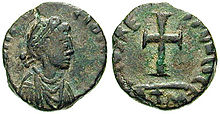The Battle of Rimini was fought in 432 between the two strong men of the Western Roman Empire, the very recently deposed Magister Utriusque Militiae Flavius Aetius and the newly appointed Magister Utriusque Militiae Bonifatius (Bonifacius or Boniface).
| Battle of Rimini | |||||||
|---|---|---|---|---|---|---|---|
 Galla Placidia, wife of Constantius III and mother of Valentinian III. | |||||||
| |||||||
| Commanders and leaders | |||||||
| Bonifacius (DOW) | Flavius Aetius | ||||||
| Strength | |||||||
| Less than 7,000 Bucellarii | Less than 7,000 Bucellarii | ||||||
| Casualties and losses | |||||||
| Bonifatius mortally wounded | Unknown | ||||||
In 430, Aetius had the Magister Utriusque Militiae Flavius Constantius Felix executed by the army, as he was allegedly plotting against Aetius. According to Wijnendaele, Aetius was lured into confronting Bonifatius by being appointed Consul in 432, where he was deposed and Bonifatius appointed by Galla Placidia. Aetius and Bonifatius then departed the court of Ravenna, gathered their bucellarii, and met five Roman miles outside of Rimini. Aetius had brought his own troops from the West where he had intended to confront the Sueves, while Bonifatius had brought part of his troops from Africa, most likely being composed of his personal bucellarii and local Italian troops.[1] Allegedly, Aetius had a longer lance and utilized it to spear Bonifatius in personal combat during the battle. Bonifatius, though victorious, was mortally wounded during the battle and died several months later.[2] He was succeeded by his son-in-law, Sebastian, who tried to have the retired Aetius assassinated. Aetius fled to the Huns and returned possibly with a large army of Huns. Sebastian, who was unpopular with the army and the court, was exiled and Aetius quickly became the de facto manager of the Western Roman Empire.[3]
Notes
edit- ^ Hughes, Ian. "Aetius: Attila's Nemesis." Pen & Sword, 2012. ISBN 1848842791 p. 85.
- ^ Wijnendaele, Jeroen P. (2016). Last of the Romans: Bonifatius - Warlord and Comes Africae. New York: Bloomsbury Academic. pp. 89–104.
- ^ Wijnendaele, Jeroen P. (2016). Last of the Romans: Bonifatius - Warlord and Comes Africae. New York: Bloomsbury Academic. pp. 105–106.
44°25′N 12°12′E / 44.417°N 12.200°E